Hardy Cacti: Living Sculptures of the American West
A few decades ago you would have been considered a hardy-cactus collector if you had a hedgehog cactus (Echinocereus) or two in your garden alongside a ball cactus (Coryphantha vivipara var. vivipara) and, of course, some prickly pears (Opuntia). Nowadays there are collectors in New England and the upper Midwest—even in the Pacific Northwest—who grow a hundred selections of cacti outdoors from a dozen or more genera. The explosion of interest in hardy cacti has come about because of the increasing availability of inexpensive, nursery-grown plants as well as more adventurous gardeners with improving horticultural skills.
Hardy cactus lovers no less than all succulent lovers owe an enormous debt to the dozens of nurseries in the American Southwest that have made choice succulents cheaply available from seed and eliminated the need to collect these sometimes rare plants in nature.
Growing Hardy Cacti
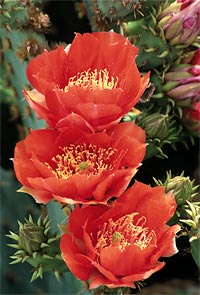
Hardy cacti have two key requirements: good drainage—especially in winter—and abundant sunshine. For this reason, they do best when grown among rocks. A rock garden or stone wall provide both a beautiful setting to display cacti and ensure the sharp drainage they need to grow as vigorously and sturdily as they would in nature. In the Rocky Mountain and Intermountain regions that receive less than 20 inches of precipitation annually, cacti usually grow well in heavy clay soils as well as sandier soils. In wetter regions, they are generally cultivated in a gravel and sand mixture. A slope with a generous three- to eight-inch topdressing of a gravel and sand mix provides more than enough drainage even in wet climates. This type of treatment helps to keep the vulnerable crowns dry and therefore less prone to rot and allows the cacti roots to reach down into the soil, where they find nutrients and moisture needed for good growth, especially in summer. Because these plants have evolved in dry regions where soil nutrients are not regularly leached by precipitation, if you garden in sand or gravel you may need to fertilize your cacti regularly. They will grow in lean soil, but to thrive they need nutrients. I prefer to use inorganic fertilizers such as Osmocote or Sierra Blend: usually a three-month formulation. Always err on the side of caution with succulents: They need to shut down growth in late summer and excess fertilizer can cause weak growth when frost comes.
Hardy Cacti in Containers
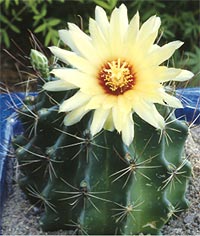
Hardy cacti also do well in containers, either in stone or stonelike materials such as hypertufa troughs or frost-proof stoneware containers. In a pot you can control the growing medium to provide the perfect mix for your plants. Even in dry Colorado, I use plenty of grit and some sand along with heavier loam to supply ballast and nutrients. Most succulent fanciers like to use scoria or other gravelly amendments to their favorite potting mix for succulents. The wetter the climate, the more gravel you need to add to the soil. I rarely use more than one-third scoria in my garden, but two-thirds may be too little in a rainy climate.
Many of the more moisture-sensitive Southwestern cacti, such as plains cactus (Sclerocactus) and fishhook cactus (Pediocactus), which invariably succumb when cultivated in open soil, no matter how well drained, thrive in containers.
A Collection of Hardy Cacti
Cacti are, of course, an endless source of fascination to gardeners in regions where the plants are native, and it is intriguing that they can provide so much pleasure to gardeners in cold climates that aren't traditional cactus territory. I remember seeing a large collection perched on a balcony in China. I have corresponded with enthusiasts across Europe and Asia who all want to capture a bit of the magic of the Southwestern landscape in the form of these most classic, gorgeous, and utterly defiant American wildflowers. The species below are just a few of the many plants available for growing in gardens and adaptable to a wide range of growing conditions.
Coryphantha
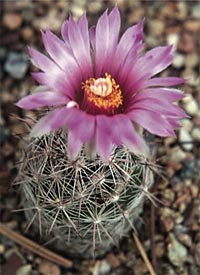
Hardy to –20°F, Coryphantha vivipara var. vivipara is the standout of another large genus containing many hardy plants. I grow a dozen or more selections and feel as though I have just scratched the surface. Imagine a baseball completely obscured by white or tan spines, and you have an instant image of this cactus when it's not in bloom. Some have stems that grow over eight inches in diameter, and some form clumps that reach over a foot across in nature. The flower color varies from pale pink to deep purple-rose, and the flowers can open from May through the summer months, depending on the individual plant. There are also half a dozen subspecies from the Southwest available commercially. A miniature form of the species that is especially white-spined and petite is sometimes found throughout the range of the species. Unfortunately, it is not distinguished botanically.
Just a trifle more tender are Coryphantha sulcata and C. scheerii, which can survive to –10°F if kept dry. Both have huge bright yellow flowers.
At first glance, the tiny ball cactus Coryphantha missouriensis seems very much like C. vivipara. The strange copper flower color and brightly colored fruit will quickly distinguish it. This cactus, hardy to –25°F, grows over much the same range as C. vivipara, yet is far less often found in gardens. Though not exactly showy, the strawyellow, brown, or amber flowers are quite appealing, as are the bright red fruit that persist from late summer to spring. It is variable over its huge range and worth obtaining in various forms.
Echinocereus
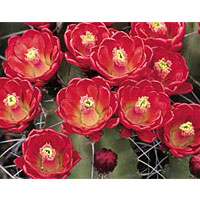
The glorious hedgehog cacti with their cylindrical symmetry, like lacy columns or gothic spires, will always hold pride of place in a hardy-cactus collection. Over a dozen species have survived repeated subzero winters, and some of these include a number of subspecies and forms, so just one genus can provide a lifetime's opportunity for the hardy-cactus lover.
The main attraction among these cacti is unquestionably Echinocereus reichenbachii, which has the greatest cold tolerance (it is hardy to –25°F) and is the least sensitive to excess moisture. Commonly known as lace cactus, this wonderful species is quickly and easily grown from seed and offers a tremendous range of flower color, spine development, form, and stem size. Different subspecies of lace cactus can range in size from a few inches to nearly two feet, with pure white to nearly black spines.
Fendler's hedgehog (Echinocereus fendleri), hardy to –20°F and almost as versatile as lace cactus, also has a number of unusual forms. The rare, corky-spined E. fendleri var. kuenzleri has become quite inexpensive in recent years and is often available. Claret cup cacti (Echinocereus coccineus, E. polyacanthus, E. triglochidiatus), also hardy to –20°F, occur in endless permutations, almost bewildering in their variability in nature and in cultivation. Flower color ranges from near orange, scarlet, and pink to deep crimson shades. Stems can vary from spineless to wildly tousled and reach anywhere from three inches to several feet tall, as in the White Sands form of E. triglochidiatus var. gonacanthus. Eventually, most forms can clump up to form mounds of almost mythic proportions. Studded with brilliant badminton-birdie flowers, they can stop traffic. Peak flowering comes from late April to June, depending on variety.
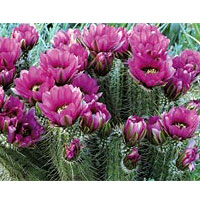
Among other cold-tolerant Echinocereus cacti is the lemon-scented E. viridiflorus, (–20°F), less showy but every bit as hardy as any of the species described above. A welter of hedgehog cacti generally found further south have northerly disjunct populations and high-altitude forms that are regularly subjected to subzero weather in nature and thus are hardier than other members of the species. These include E. dasyacanthus, E. engelmanii, E. enneacanthus, E. knippelianus, E. viereckii, and others. Most of these are doing fine in Denver, which lies in USDA Zone 5 (–20°F). I wouldn't try to grow most of them in wetter regions colder than Zone 7, however, unless they could be kept in an unusually protected microclimate with ideal soil conditions. Seek out the most cold-tolerant cultivar for testing. Larger plants tend to survive the first winter better than tiny seedlings. If you have small seedlings or plants, I recommend leaving them in the seed pot rather than planting them out too early.
Escobaria
Quite a few species in the genus Escobaria, which is closely related to Mammillaria, have proven themselves in a wide range of climates. Escobaria sneedii var. leei, hardy to –20°F, is one of our tiniest and rarest cacti, restricted in nature to the Carlsbad Cavern area in Texas. In cultivation it thrives almost everywhere in North America, in places as diverse as New England rock gardens and troughs in Colorado. It makes a huddled mound of marble-size stems densely covered in white-spines, with pale pink flowers in early summer. Escobaria sneedii var. sneedii, hardy to –15°F, is similar in form but larger and with pinker flowers. Larger still is E. organensis, hardy to –15°F. The largest relative is E. orcuttii, hardy to –15°F, from the mountains of southern New Mexico and yet extremely hardy far northward. These are all rather small plants, rarely more than a foot at the very biggest—either in height or spread. Escobaria hesteri and E. minima, which resemble dwarf races of Corypantha vivipara, can survive to –10°F in dry-winter regions.
Maihuenia poepiggii
Surprisingly, this prickly pear cousin with cylindrical stems and persistent tubular true leaves has grown vigorously for many years in gardens throughout the Pacific Northwest, where it is the best-performing outdoor cactus. It even blooms prolifically there, producing luminous, two-inch pale yellow roselike flowers. It is hardy to –15°F and can survive even colder temperatures in the interior West.
Opuntia, Cylindropuntia, and Grusonia
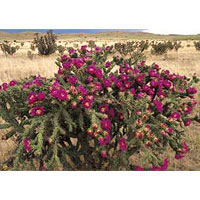
A common sight in the Southwest, some chollas take a shrublike form, like these wild-growing specimens; other species grow to tree size or creep along the ground.
The endless variations of prickly pear, cholla, and creeping cylindrical opuntia are the glory and bane of the hardy-cactus garden: Few plants combine such brilliant flowers and architectural stems and forms with such painful spines and glochids (spines that come off easily). The secret for growing Opuntia and closely allied genera is siting them where they won't need constant care. I prefer to grow them primarily in large pots, where they droop gracefully and are easily weeded and maintained. Strategically positioned among rocks, they can likewise be managed for years without the need for cleanup and cutting back that can cause gardeners such discomfort. And opuntias are so easily propagated by severing and planting a pad, or even part of a pad, that there is no excuse for not quickly building a wonderful collection.
Scattered over the eastern two-thirds of the United States and a short way into Canada, Opuntia humifusa may be the most widely distributed prickly pear. It is certainly the most widely cultivated. Most forms are nearly spineless, and even its glochids are less lethal than those of most western prickly pears. In summer, the bright green mass of stems provides a fine contrast to the predominant silvers and grays of other cacti, but in winter it wilts into a limp mass of darkened matter aptly described as "depressa." In spring, it resurrects miraculously within weeks of the return of warm weather. It can be dazzling in early summer, when it is intermittently covered with bright yellow flowers. Despite its wide range, there have been surprisingly few selections: O. humifusa 'Lemon Spreader' is one of the few cultivars. The closely related O. macrorrhiza of the southern Rockies seems to be much more variable in both pad shape and flower color. As with so many cacti, the potential for hybridization is limitless.
Over much of the 20th century, some of the finest Opuntia selections were made by Claude Barr, the great nurseryman of the Great Plains: His clones Opuntia 'Crystal Tide' (–25°F), 'Claude Arno' (–25°F), and others still form the basis of many hardy cactus gardens. These are mostly hybrids of O. polyacantha, the commonest cactus in the West.
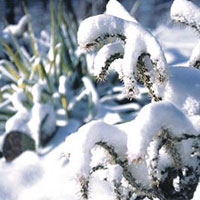
Opuntia fragilis (–35°F) has the honor of being the most northerly cactus, growing hundreds of miles north of the Canada-U.S. border. It has provided many fascinating selections, including nearly spineless forms with spherical pads and bright bright pink or yellow flowers produced quite generously. Hunger cactus (O. polyacantha, hardy to –25°F) must be the most abundant western species, with flowers in every imaginable shade of yellow to pink and deep red. Opuntia phaeacantha (hardy to –20°F) is nearly as variable, with statuesque pads, especially in the tall variety (O. engelmannii, hardy to –15°F). It is not unheard of to find these up to six feet tall.
Few plants are as statuesque as Cylindropuntia imbricata (hardy to –15°F) and its many cousins: C. echinocarpa (–15°F), C. kleiniae (–20°F), C. leptocaulis (–20°F), and C. spinosior (–15°F). These form tall, almost treelike candelabra with midsummer flowers and showy autumnal seedpods.
The creeping cylindrical opuntias of the Southwest have had a botanical name change and are now called Grusonia. The hardiest of these is undoubtedly G. clavata (–25°F), with wide, bright white sheathlike spines and a dense, creeping habit that is as appealing as the two-inch pale yellow flowers. In nature, this plant can spread many feet across: Gardeners are pleased if it spreads to a foot after many years, however.
Pediocactus and Sclerocactus
Plants of high, cold, dry mountain ridges or hot deserts, most species of plains cactus and fishhook cactus grow in regions where subzero cold is a frequent winter phenomenon, making them endlessly teasing to gardeners in cold climates. They are useful in dry-region gardens where gardeners control their impulse to water, but they are only apt to gain wide currency in wet regions if and when they can be obtained grafted onto moisture-tolerant rootstocks, such as Opuntia fragilis or perhaps Coryphantha vivipara. Though grafted plants are rarely available, you can perhaps do the grafting yourself—it's not as hard as you might imagine.
More Cacti
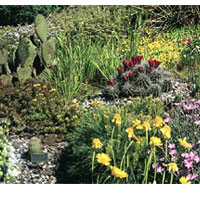
Quite a few unusual ball cacti have gained wide currency, although they are more challenging in wetter regions: Echinocactus texensis, Echinomastus intertextus, Epithelantha micromeris, Hamatocactus bicolor, and Mammillaria wrightii all have cold-hardy variants that can survive subzero cold provided they stay dry. Gardeners in the interior West have brought a surprising range of South American cacti through many winters, including Echinopsis (often sold and listed in catalogs as Lobivia), Gymnocalycium, Parodia (often sold and listed as Notocactus), as well as numerous opuntioids such as Maihueniopsis, Puna, and Tephrocacti, which are all subject to extreme cold in the Andes. There is now such a wealth of data available on many South American cacti that I expect they will be a large new basis for experimentation in the coming decades.


